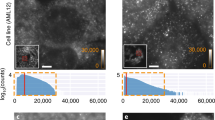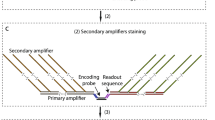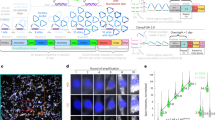Abstract
The ability to visualize RNA in its native subcellular environment by using single-molecule fluorescence in situ hybridization (smFISH) has reshaped our understanding of gene expression and cellular functions. A major hindrance of smFISH is the difficulty to perform systematic experiments in medium- or high-throughput formats, principally because of the high cost of generating the individual fluorescent probe sets. Here, we present high-throughput smFISH (HT-smFISH), a simple and cost-efficient method for imaging hundreds to thousands of single endogenous RNA molecules in 96-well plates. HT-smFISH uses RNA probes transcribed in vitro from a large pool of unlabeled oligonucleotides. This allows the generation of individual probes for many RNA species, replacing commercial DNA probe sets. HT-smFISH thus reduces costs per targeted RNA compared with many smFISH methods and is easily scalable and flexible in design. We provide a protocol that combines oligo pool design, probe set generation, optimized hybridization conditions and guidelines for image acquisition and analysis. The pipeline requires knowledge of standard molecular biology tools, cell culture and fluorescence microscopy. It is achievable in ~20 d. In brief, HT-smFISH is tailored for medium- to high-throughput screens that image RNAs at single-molecule sensitivity.
This is a preview of subscription content, access via your institution
Access options
Access Nature and 54 other Nature Portfolio journals
Get Nature+, our best-value online-access subscription
$29.99 / 30 days
cancel any time
Subscribe to this journal
Receive 12 print issues and online access
$259.00 per year
only $21.58 per issue
Buy this article
- Purchase on Springer Link
- Instant access to full article PDF
Prices may be subject to local taxes which are calculated during checkout








Similar content being viewed by others
Code availability
Oligostan-HT is available at https://hub.docker.com/r/oligostan/oligostan_ht_rna alongside documentation and test data. FISH-quant v2 for image analysis is available at https://github.com/fish-quant.
References
Chin, A. & Lécuyer, E. RNA localization: making its way to the center stage. Biochim. Biophys. Acta Gen. Subj. 1861, 2956–2970 (2017).
Buxbaum, A. R., Haimovich, G. & Singer, R. H. In the right place at the right time: visualizing and understanding mRNA localization. Nat. Rev. Mol. Cell Biol. 16, 95–109 (2015).
Kejiou, N. S. & Palazzo, A. F. mRNA localization as a rheostat to regulate subcellular gene expression. Wiley Interdiscip. Rev. RNA 8, (2017).
Lee, C.-D. & Tu, B. P. Glucose-regulated phosphorylation of the PUF protein Puf3 regulates the translational fate of its bound mRNAs and association with RNA granules. Cell Rep. 11, 1638–1650 (2015).
Böckler, S. & Westermann, B. Mitochondrial ER contacts are crucial for mitophagy in yeast. Dev. Cell 28, 450–458 (2014).
Safieddine, A. et al. A choreography of centrosomal mRNAs reveals a conserved localization mechanism involving active polysome transport. Nat. Commun. 12, 1352 (2021).
Lécuyer, E. et al. Global analysis of mRNA localization reveals a prominent role in organizing cellular architecture and function. Cell 131, 174–187 (2007).
Yoon, Y. J. et al. Glutamate-induced RNA localization and translation in neurons. Proc. Natl Acad. Sci. USA 113, E6877–E6886 (2016).
Singer-Krüger, B. & Jansen, R.-P. Here, there, everywhere. mRNA localization in budding yeast. RNA Biol. 11, 1031–1039 (2014).
Chang, P. et al. Localization of RNAs to the mitochondrial cloud in Xenopus oocytes through entrapment and association with endoplasmic reticulum. Mol. Biol. Cell 15, 4669–4681 (2004).
Medioni, C., Mowry, K. & Besse, F. Principles and roles of mRNA localization in animal development. Dev. Camb. Engl. 139, 3263–3276 (2012).
Chouaib, R. et al. A dual protein–mRNA localization screen reveals compartmentalized translation and widespread co-translational RNA targeting. Dev. Cell 54, 773–791.e5 (2020).
Kwon, O. S. et al. Exon junction complex dependent mRNA localization is linked to centrosome organization during ciliogenesis. Nat. Commun. 12, 1351 (2021).
Sepulveda, G. et al. Co-translational protein targeting facilitates centrosomal recruitment of PCNT during centrosome maturation in vertebrates. eLife 7, e34959 (2018).
Chen, L.-L. Linking long noncoding RNA localization and function. Trends Biochem. Sci. 41, 761–772 (2016).
Cabili, M. N. et al. Localization and abundance analysis of human lncRNAs at single-cell and single-molecule resolution. Genome Biol. 16, 20 (2015).
Kloc, M., Dallaire, P., Reunov, A. & Major, F. Structural messenger RNA contains cytokeratin polymerization and depolymerization signals. Cell Tissue Res. 346, 209–222 (2011).
Garcia-Jove Navarro, M. et al. RNA is a critical element for the sizing and the composition of phase-separated RNA–protein condensates. Nat. Commun. 10, 3230 (2019).
Femino, A. M., Fay, F. S., Fogarty, K. & Singer, R. H. Visualization of single RNA transcripts in situ. Science 280, 585–590 (1998).
Pichon, X., Lagha, M., Mueller, F. & Bertrand, E. A growing toolbox to image gene expression in single cells: sensitive approaches for demanding challenges. Mol. Cell 71, 468–480 (2018).
Tsanov, N. et al. smiFISH and FISH-quant - a flexible single RNA detection approach with super-resolution capability. Nucleic Acids Res. 44, e165 (2016).
Battich, N., Stoeger, T. & Pelkmans, L. Image-based transcriptomics in thousands of single human cells at single-molecule resolution. Nat. Methods 10, 1127–1133 (2013).
Sinnamon, J. R. & Czaplinski, K. RNA detection in situ with FISH-STICs. RNA 20, 260–266 (2014).
Marx, V. Method of the year: spatially resolved transcriptomics. Nat. Methods 18, 9–14 (2021).
Method of the year 2020: spatially resolved transcriptomics. Nat. Methods. 18, 1–1 (2021).
Wang, G., Moffitt, J. R. & Zhuang, X. Multiplexed imaging of high-density libraries of RNAs with MERFISH and expansion microscopy. Sci. Rep. 8, 4847 (2018).
Lubeck, E., Coskun, A. F., Zhiyentayev, T., Ahmad, M. & Cai, L. Single-cell in situ RNA profiling by sequential hybridization. Nat. Methods 11, 360–361 (2014).
Eng, C.-H. L. et al. Transcriptome-scale super-resolved imaging in tissues by RNA seqFISH. Nature 568, 235 (2019).
Shah, S. et al. Dynamics and spatial genomics of the nascent transcriptome by intron seqFISH. Cell 174, 363–376.e16 (2018).
Eng, C.-H. L., Shah, S., Thomassie, J. & Cai, L. Profiling the transcriptome with RNA SPOTs. Nat. Methods 14, 1153–1155 (2017).
Goh, J. J. L. et al. Highly specific multiplexed RNA imaging in tissues with split-FISH. Nat. Methods 17, 689–693 (2020).
Chen, X., Teichmann, S. A. & Meyer, K. B. From tissues to cell types and back: single-cell gene expression analysis of tissue architecture. Annu. Rev. Biomed. Data Sci. 1, 29–51 (2018).
Close, J. L., Long, B. R. & Zeng, H. Spatially resolved transcriptomics in neuroscience. Nat. Methods 18, 23–25 (2021).
Zhuang, X. Spatially resolved single-cell genomics and transcriptomics by imaging. Nat. Methods 18, 18–22 (2021).
Larsson, L., Frisén, J. & Lundeberg, J. Spatially resolved transcriptomics adds a new dimension to genomics. Nat. Methods 18, 15–18 (2021).
Lee, J. H. et al. Fluorescent in situ sequencing (FISSEQ) of RNA for gene expression profiling in intact cells and tissues. Nat. Protoc. 10, 442–458 (2015).
Ke, R. et al. In situ sequencing for RNA analysis in preserved tissue and cells. Nat. Methods 10, 857–860 (2013).
Chen, X., Sun, Y.-C., Church, G. M., Lee, J. H. & Zador, A. M. Efficient in situ barcode sequencing using padlock probe-based BaristaSeq. Nucleic Acids Res. 46, e22 (2018).
Liu, S. et al. Barcoded oligonucleotides ligated on RNA amplified for multiplexed and parallel in situ analyses. Nucleic Acids Res. 49, e58 (2021).
Alon, S. et al. Expansion sequencing: Spatially precise in situ transcriptomics in intact biological systems. Science 371, eaax2656 (2021).
Wang, X. et al. Three-dimensional intact-tissue sequencing of single-cell transcriptional states. Science 361, eaat5691 (2018).
Mueller, F. et al. FISH-quant: automatic counting of transcripts in 3D FISH images. Nat. Methods 10, 277–278 (2013).
Samacoits, A. et al. A computational framework to study sub-cellular RNA localization. Nat. Commun. 9, 4584 (2018).
Imbert, A. et al. FISH-quant v2: a scalable and modular tool for smFISH image analysis. RNA 28, 786–795 (2022).
Bahry, E. et al. RS-FISH: Precise, interactive, fast, and scalable FISH spot detection. Preprint at bioRxiv https://doi.org/10.1101/2021.03.09.434205 (2021).
Perkel, J. M. Starfish enterprise: finding RNA patterns in single cells. Nature 572, 549–551 (2019).
Eichenberger, B. T., Zhan, Y., Rempfler, M., Giorgetti, L. & Chao, J. A. deepBlink: threshold-independent detection and localization of diffraction-limited spots. Nucleic Acids Res. 49, 7292–7297 (2021).
Savulescu, A. F. et al. Interrogating RNA and protein spatial subcellular distribution in smFISH data with DypFISH. Cell Rep. Methods 1, 100068 (2021).
Rouhanifard, S. H. et al. ClampFISH detects individual nucleic-acid molecules using click chemistry-based amplification. Nat. Biotechnol. 37, 84–89 (2019).
Yaroslavsky, A. I. & Smolina, I. V. Fluorescence imaging of single-copy DNA sequences within the human genome using PNA-directed padlock probe assembly. Chem. Biol. 20, 445–453 (2013).
Choi, H. M. T. et al. Programmable in situ amplification for multiplexed imaging of mRNA expression. Nat. Biotechnol. 28, 1208–1212 (2010).
Pichon, X. et al. The kinesin KIF1C transports APC-dependent mRNAs to cell protrusions. RNA 27, 1528–1544 (2021).
Ouyang, W., Mueller, F., Hjelmare, M., Lundberg, E. & Zimmer, C. ImJoy: an open-source computational platform for the deep learning era. Nat. Methods 16, 1199–1200 (2019).
Rio, D. C. Expression and purification of active recombinant T7 RNA polymerase from E. coli. Cold Spring Harb. Protoc. 2013, pdb.prot078527 (2013).
Xu, Q., Schlabach, M. R., Hannon, G. J. & Elledge, S. J. Design of 240,000 orthogonal 25mer DNA barcode probes. Proc. Natl Acad. Sci. USA 106, 2289–2294 (2009).
Acknowledgements
A.S. was supported by the Agence Nationale de la Recherche (ANR, grant no. ANR 19-CE12-0024-01) and fellowships from the Ministère de l’Enseignement Supérieur, de la Recherche et de l’Innovation (MESRI) and the Fondation pour la Recherche Médicale (FRM). This project was supported by France BioImaging (ANR-10-INBS-04), the ANR (grants ANR-11-BSV8-018-02 and ANR-14-CE10-0018-01), the FRM ‘Bioinformatics’ grant, the Pasteur Institut, the Ligue Nationale Contre le Cancer and the Labex EpiGenMed from the framework ‘Investissements d’avenir.’
Author information
Authors and Affiliations
Contributions
The HT-smFISH methodology was conceived by E.B. and developed by A.M-T., C.H.-K., C.-H.L., E.B., E.C., F.L., M.P., T.G. and V.G. Oligostan-HT was developed by T.G. with input from E.B., and C.-H.L. for barcoding and target selection. The RNA localization analysis pipeline FISH-quant v2 was developed by A.I., F.M. and T.W. S.S. performed experiments in tissue. A.S. wrote the manuscript with input from E.B. A.S. made the figures. All authors reviewed the manuscript.
Corresponding authors
Ethics declarations
Competing interests
The authors declare no competing interests.
Peer review
Peer review information
Nature Protocols thanks Mona Batish and the other, anonymous, reviewer(s) for their contribution to the peer review of this work.
Additional information
Publisher’s note Springer Nature remains neutral with regard to jurisdictional claims in published maps and institutional affiliations.
Related links
Key references using this protocol
Safieddine, A. et al. Nat. Commun. 12, 1352 (2021): https://doi.org/10.1038/s41467-021-21585-7
Kwon, O. S. et al. Nat. Commun. 12, 1351 (2021): https://doi.org/10.1038/s41467-021-21590-w
Supplementary information
Supplementary Table 1
Barcodes and PCR barcode primers to be ordered. The primers are organized by plate and ID. Oligostan-HT uses this order such that the first two primers of plate 1 (wells A1 and A2) are used to PCR the first probe set in the Oligostan-HT output file, the next two (wells A3 and A4) for the second probe set, and so on.
Supplementary Table 2
A sample of Oligostan-HT’s output. The output is shown in an Excel sheet with several columns. ENST, ensemble transcript identifier; ENSGx, ensemble gene identifier; GeneName, name of gene or RNA; SET, the experiment to which the probe set belongs; dGOpt, ΔG37°C reference value (yielding the highest number of probes); Start/End Pos, the start and end position of the probe with respect to the target transcript’s coding sequence; ProbeSize, the length of the probe’s hybridization sequence; Seq, the probe’s hybridization sequence; dGScore and dG37, ΔG37°C score (higher is better) and value; GCpc, percentage of GC in the hybridization sequence; GCFilter, whether the probe satisfies the specified % GC filter; aCompFilter, whether the probe contains an A nucleotide composition <28%; aStackFilter, whether the probe does not contain AAAA stacks; cCompFilter, whether the probe contains an C nucleotide composition between 22% and 28%, cStackFilter, whether the probe does not contain CCCC stacks; cSpecStackFilter, whether the probe does not contain four nonconsecutive Cs in any six consecutive nucleotides in the first twelve positions; NbOfPNAS, the number of filters satisfied (from ref. 55); PNASFilter, whether the probe satisfies the assigned number of PNAS filters; RSESeqFilter, whether probes contain a restriction enzyme site, filter not used; InsideUTR, whether the probe is inside a UTR; BC1ID, ID of the first barcode to be used to amplify the probe; BC1PN, the number of the plate in which the barcode is stored; BC1WP, position of the barcode in the 96-well plate; BC1, sequence of barcode 1; BC2ID, BC2PN, BC2WP, BC2, same as barcode 1, but for barcode 2; BC1-Y-Hyb-X-BC2, sequence resulting from concatenation of barcode 1– readout Y–hybridization sequence–readout X–barcode 2; WithComplementSeq, same but with a few additional nucleotides to normalize all oligonucleotide length to facilitate synthesis. This column has the oligo pool sequences to be ordered.
Rights and permissions
Springer Nature or its licensor (e.g. a society or other partner) holds exclusive rights to this article under a publishing agreement with the author(s) or other rightsholder(s); author self-archiving of the accepted manuscript version of this article is solely governed by the terms of such publishing agreement and applicable law.
About this article
Cite this article
Safieddine, A., Coleno, E., Lionneton, F. et al. HT-smFISH: a cost-effective and flexible workflow for high-throughput single-molecule RNA imaging. Nat Protoc 18, 157–187 (2023). https://doi.org/10.1038/s41596-022-00750-2
Received:
Accepted:
Published:
Issue Date:
DOI: https://doi.org/10.1038/s41596-022-00750-2
This article is cited by
Comments
By submitting a comment you agree to abide by our Terms and Community Guidelines. If you find something abusive or that does not comply with our terms or guidelines please flag it as inappropriate.



